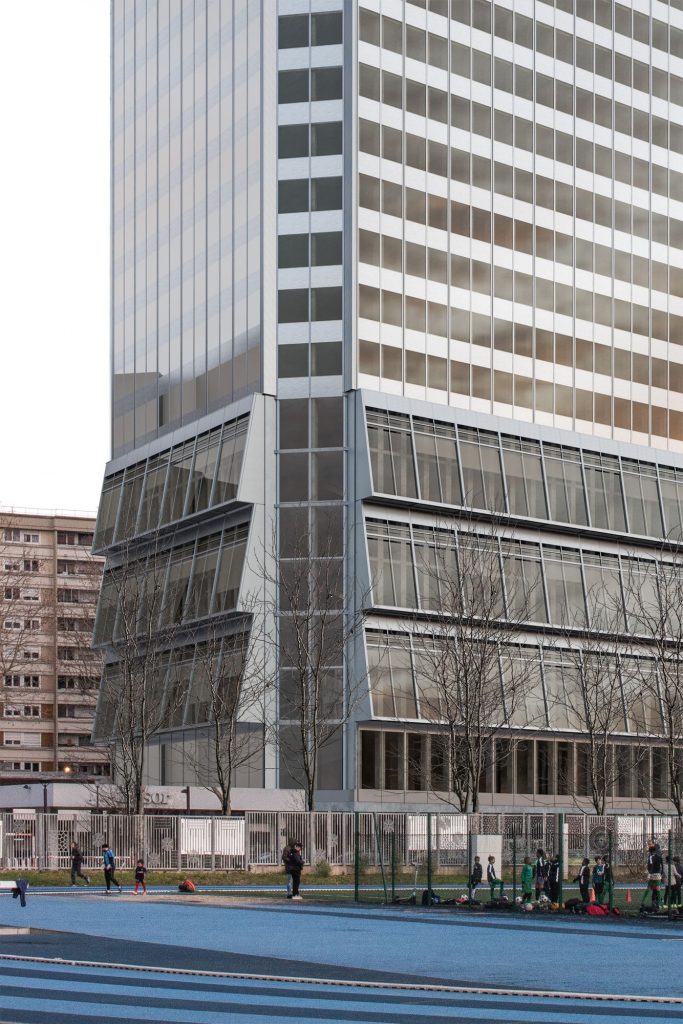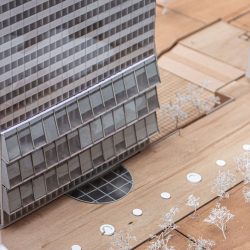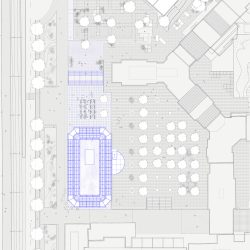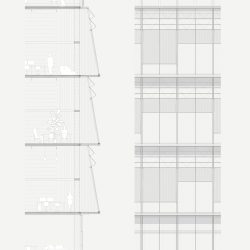
At Porte de Pantin, facing the Paris ring road, stands the Essor Tower, an office building built in 1976 wich is almost fully abandoned. Obsolete and aging, half-occupied, this glass and concrete body is a typical example vacant capable volumes that can be found all over the metropolis. Forum 27 makes the Tour Essor a prototype for a new metropolitan hybrid. It proposes a gradual and partial metamorphosis of the infrastructure, considering disuse as a project material. By giving way to new forms of intermediary occupation, the project extends the debate on the former Office Building. The aim is to create a place of culture and education for local residents and the population from all over Paris. The heart of the intervention lies in the redesign of the infra, i.e. the climatic, lighting and spacial elements that will make the structure capable for a radically new use. Beyond the program, the project aims to graft new vital organs and reconnect the Tower to its immediate environment. Each level is a surface of total freedom, where city residents can experience life in the metropolis in a new and sensitive way.
Metropolis refers to material and immaterial systems of relationships that make up a major capital city. The metropolis is the place where the senses are excited by the intense flow of goods, capital, knowledge and customs. Within its territory, everything is given a role, a definition, a destination. The city is the physical body of the metropolis. In its places, it contains the relationships of the different elements of the system. Its spaces are explicitly identified in everyone’s mind: the square, the street, the park, the building, the district, the infrastructure.
The non-linear evolution of the metropolis fabric sometimes leads to anomalies. Abandonment, desertion, downgrading. As a result of municipal decisions, changing mores, social and economic episodes, places slip out of the great system of relationships. These places populate the edges, in a latent state, waiting for a new event to change the course of their existence. Sometimes, under particular conditions, these places – wastelands, ruins, residual spaces – can be the stage for a completely different kind of occupation while being in their liminal stage.
The major commercial developments of the 1960s and 70s shaped the face of Paris that we inherited, bringing steel and glass towers to the skyline. These buildings, designed by emblematic figures of the era such as Raymond Lopez, Pierre Dufau and Jean de Mailly, symbolise the rise of Big Corporation, embodied in the values of international style. Office buildings were built at La Défense, on the Grenelle slab and around the Gare Montparnasse. These abstract objects owe their success to the massive mechanisation of their air conditioning systems and the development of lifts. For more than thirty years, office buildings were the image of corporate development and, by extension, that of the metropolis. Today, in times of recession and health and climate crises, they are a distant memory of an impossible ideal. Since the late 1990s, Parisian office towers have been emptying out. Suffering from a lack of maintenance of their mechanical systems and an outdated aesthetic, these monuments have been abandoned in favour of Haussmann-style buildings, closer to city centres
At Porte de Pantin, facing the Paris ring road, stands the Essor Tower, an office building built in 1976 and now virtually derelict. Obsolete and ageing, this glass and concrete carcass is a typical example of a dormant tertiary sector building of the kind found in Greater Paris. The Essor Tower is the only high-rise building around the Paris ring road not to have been renovated. No major renovation or upgrading has been carried out since it was delivered 50 years ago. The building is now half-occupied by small businesses, some of which can no longer afford to pay the charges incurred by the building’s energy consumption. The Tower has been up for sale for several months. No buyer has yet been found. The dimensions of the plateau, the size of the traffic core and the IGH standard were deemed too restrictive by the promoters to allow housing to be built there.
How can an office building from the 1970s be redeveloped to meet multiple needs and uses over the long term? Is there a way out of the inexorable obsolescence to which architecture is doomed by the ever-faster pace of change in our society?
Following in the footsteps of Tiphaine Abenia, an architect, researcher and lecturer at ULB (Brussels), who has been working on these so-called liminal architectures, Forum 27 is proposing to install a new metropolitan hybrid in the Essor Tower. It develops a scenario for the gradual metamorphosis of the infrastructure over more than 50 years, envisaging the state of abandonment as constitutive of the project. By giving way to new forms of intermediary occupation, the project extends the debate on this former symbol of the Office Building. The aim is to create a place of culture and education for the residents of the immediate neighbourhood and those from all over Paris. The heart of the project lies in the restructuring of the infra-structure, i.e. the climatic, lighting and spatial elements that will make the structure capable of use. Beyond the programme, the aim of the project is to graft new vital organs and reconnect the Tower with its immediate environment. Each plateau is a space of total freedom, where city dwellers can experience life in the metropolis in a new and sensitive way. The graft takes place in the lower part of the building, providing the necessary impetus for new temporary, fleeting and frugal occupations. The cultural centre and incubator for young creators is set to embark on its own transformation. The other upper floors of the Tower will be left completely empty. They then become a maze for a new collective imagination. An infrastructure that could become a campsite or a festival, a village hall or a health centre.
‘For the liminal phase to have an impact on the rest of the structure’s life cycle, it is up to us, as architects, to seize the reflexive conditions that the abandonment made it possible to initiate. It’s a question of extending the conditions for debate, making an inventory of the plurality of futures, activating the mythical dimension that has been collected and enhancing the popular practices at work during the time-space of abandonment’ – Tiphaine Abenia
_
University
Ecole d’Architecture de la Ville et des Territoires Paris Est
Master
Éléments, Structure, Architecture
Type
Master thesis project
Professor
Léonard Lassagne, Laure Veyre de Soras, Vanessa Pointet
Year
2024























